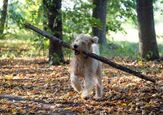Adding a Degu to the Family? Let's Get You Properly Set Up!

(photo credit: UltraFLyer / shutterstock.com)
Introducing a new pet to the family is always an exciting experience, and for those of us who have been around this block a time or two, I think we’d all agree that the best advice for newbies is this: prepare in advance. Nothing takes the fun out of introducing a furry new friend to the household faster than completely underestimating their care needs and having to scramble at the last minute. Or worse, rehome because we haven’t anticipated what’s expected of us.
Now, when it comes to all those smaller furry pets that have become so popular with the younger set, the playful little degu – AKA Chilean squirrel - is starting to lead the pack. Not only is this social little guy quick to bond with family members and highly energetic, but it requires just enough maintenance to encourage responsible pet ownership with the kiddos.
You see, when they’re young, degus need lots of cuddles to help them become comfortable with their new peeps. And who better to sign up for that duty than the junior members of the family, right? Gentle handling with parents supervising helps build confidence and teaches kids how to respect their new pet’s boundaries. It also helps them understand the animal’s unique needs while they settle into new surroundings. Failure to take the time to build familiarity can result in a stressed-out degu and warning nips that are intended to send a message.
Now, let’s talk about those unique needs. Degus don’t land in the same category as a rabbit, guinea pig, gerbil, or hamster when it comes to care and feeding. Their diet is a little more specific in terms of what they can and cannot eat, as well as the types of toys and bedding they prefer. Similar to when you adopt any type of pet, once you’ve taken the time to organize the right set-up and establish a suitable care, feeding, and exercise regimen, it easily becomes a natural part of your daily schedule, with the benefits far outweighing any challenges.
Sleeping Arrangements
Here’s a bit of good news! Unlike hamsters or pet rats, these little guys are not nocturnal. They prefer to be active during the day, and that means no busy feet running on a squeaky hamster wheel to keep everyone awake after dark. That said, they do enjoy a good chatter, squeak and warble when they’re feeling content and cozy, so if you work from home, you may want to consider an appropriate location for their cage.
As a new degu pet parent, you’re about to find out that this furry family member - larger than a hamster and more active than a rabbit – needs the right type of accommodation to keep them happy. For this type of small yet energetic animal, it’s important to have a multi-level pet cage with enough room for them to climb and move around when the mood strikes. This metal option from Mcage is compact enough to set atop a table and includes a raised grate floor and pull-out, washable tray for easy (daily) cage cleaning. Those tiers help him burn off energy, while the open wire grate encourages continual interaction to ensure your new degu enjoys the social side of being a family member.
If you have a little more floor space, this 48-inch, four-level small pet cage from Pawhut is the way to go. Rolling wheels allow you to move your degu from windows and sunlight to bedrooms at nighttime and even the great outdoors when balmy weather calls. Three platforms and a fun little hammock help keep your pet happily active and entertained when he’s not out and about, playing with his family. And because degus have a continual need to gnaw and chew to keep their always-growing teeth in check, the metal wire frame of these two cages is the right pick for this type of pet.
Let’s talk bedding!
Degus’ love of chewing means their nesting material cannot be wood chips which they might consume but can’t digest. So, bedding for this little guy needs to be a top-quality paper-based product. Either shredded white or recycled paper is best because it’s non-toxic and easily digested if your degu decides to nosh away. Better still, it’s fragrance-free, soft on paws, and this Kaytee brand is more absorbent than many of the competitors.
And because their natural habitat includes lots of burrowing, they need a cozy hideaway they can retreat to after a fun-filled day. Enter this roomy little igloo constructed from durable, stain and odor-resistant plastic. A semi-transparent finish makes it easy to monitor your pet’s activities while still providing them with an important “hiding” space to snuggle into.
Something to Munch On
The degu diet is not like that of a hamster, gerbil, or rabbit. While they are all herbivores, degus can be prone to diabetes, and that means they require a low-sugar, low-fat diet – so no fruit or treats that contain molasses or honey. Also no to the high-fat, high-protein seeds commonly contained in hamster feed.
So, what can they eat? Because they come from an environment where their diet consisted of high-fiber grasses, a simple, fibre-rich hay is going to be a big component of his daily diet. But not just any hay. Plan to stock up on timothy or orchard grass versus alfalfa hay, which tends to be higher in calories and protein. And keep all that dry, loose grass neat and tidy with a side-mounted small pet feeder. Easy to fill, clean and for your degu to access.
Want to vary up their diet? Add dry, pellet-style guinea pig feed, fresh greens such as broccoli, parsley, kale, and even dandelion greens, then toss in a small piece of sweet potato or cucumber for a special treat.
Remember that earlier comment about how this small furry pet loves to chew to help wear down continually growing teeth? That’s why you need to toss a few safe, natural wood chew toys for gnawing, into his living space.
Grooming
If you’ve never lived with a guinea pig, hamster, gerbil, or degu before, you might be surprised to learn that they love what’s called a “dust bath”. Choose a natural, commercial-grade dust that’s specifically formulated for use by smaller pets like this ultra-fine dust from Oxbow POOF! Any option should be free of fragrance, silica, or clay and be offered to your little buddy two to three times a week. Pour a small amount into a bowl large enough for your degu to roll around in, yet steep enough not to tip over. Let him roll around for about 30 minutes to help absorb oils and maintain a clean, healthy coat. Then remove the bowl to prevent it from becoming contaminated with urine or feces.

Sharing space with three seriously judgy Schnoodles and 2 felines who prefers to be left alone. #LivingMyBestLife
More by Mary Simpson



























